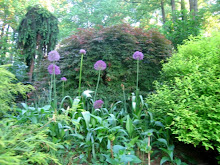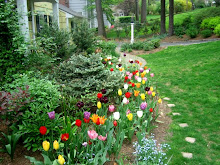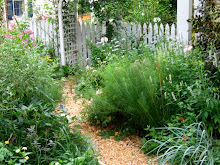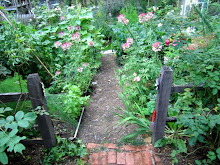One of this season's projects has been to better protect the vegetable garden. As frequent readers of this blog know, enemy number one is the groundhog that lives next door in my neighbor's yard. The extra tall fence around my backyard keeps out the deer and my one year-old cat effectively deters most of the smaller pests--rabbits, squirrels and chipmunks. Unfortunately, I have been ineffective against the groundhog.
.
Part 1 of this year's project was to build a chicken wire fence cover over one of the raised beds with short vegetables. You can read about that here.
.
Part 2 of this year's project was to reinforce the open post and rail fence with chicken wire and build pest proof gates for the three openings. You can read about that here.
.
After parts 1 and 2 of this project, the first two months of the growing season were pest free with no break-ins from the groundhog. Then, last week, he broke in. I don't know how he did it, but he did. My poor beans and cucumbers were mowed down. He even had the audacity to push the chicken wire cover off just enough to squeeze in and help himself to some Russian kale. After having such a good start to the season, and seeing the damage he did in a single visit, I must confess that I thought of just giving up. My son responded with my own words: there is no giving up in gardening. I told my husband that he had to do something.
.
How to Protect the Vegetable Garden, Part 3
.
.
a. Buy eight foot 1x2s. We needed four 5'x8' screens for each raised bed, so my husband needed to buy thirty-two for the two raised beds we wanted to protect.
.
b. Cut your 1x2s to the desired length.
.
c. Nail your 1x2s together to make the frames of your screens. My husband put two 1 1/2 inch nails into each corner.
.
d. Cover your frames with deer fence netting. For such a large area, this is much lighter, cheaper and easier to work with than the chicken wire.
.
e. Nail two screens to the sides of your vegetable box where you need the least access.
.
f. Tie the other two screens to the fixed screens with rope that can easily be untied and re-tied for your access.
.
Hopefully, there will not be a Part 4 of this year's story.
Welcome to Heirloom Gardener
Friday, July 03, 2009
How to Protect the Vegetable Garden from the Groundhog, Part 3: New Eight Foot Tall Screens Around the Raised Beds
Posted by
Julia Erickson
at
6:00 AM
![]()
![]()
Labels: Gardening Tools and Structures, Heirloom and Organic Food, Pest Control
Subscribe to:
Post Comments (Atom)
Search Heirloom Gardener
Labels
- About Blogging
- Annuals/Biennials and Perennials
- Autumn Garden
- Books and Movies
- Botanical Gardens
- Bulbs and Tubers
- Children's Garden
- Chrysanthemum
- Clematis
- Container Gardening
- Crocus tommasiniasus roseus
- Cut and Forced Flowers
- Cutting and Rose Gardens
- Dahlias
- Deep Thoughts About Gardening
- Egg Garden
- Fences Arbors Walls and Paths
- Floral arrangements
- Front Border
- Fun Stories About Gardening
- Garden Bloggers' Bloom Day
- Garden Bloggers' Design Workshop
- Garden Planning
- Gardening Blogs
- Gardening Tools and Structures
- Gardening with Children
- Goldberry Hill
- Heirloom and Organic Food
- Hibiscus
- Holidays
- Hydrangeas
- Japanese Beautyberry
- Lilies
- Mixed Borders
- New Jersey / Local Interest
- Nurseries
- Online Gardening Resources
- Peonies
- Pest Control
- Picture This Photo Contest
- Piet Oudolf
- Poppies
- Propagation and Seeds
- Pruning and Maintenance
- Roses
- Seed Heads
- Self Seeders
- Shrubs
- Spring Garden
- Summer Garden
- Trees
- Wildlife in the Garden
- Winter Garden
- Zinia
Blog Archive
-
▼
2009
(257)
-
▼
July
(36)
- A Summer Visit to the New York Botanical Garden (N...
- A Summer Visit to the New York Botanical Garden (N...
- A Summer Visit to the New York Botanical Garden (N...
- More Ticks, More Misery: A mother's experience in...
- Lightning, Thunder, Hail and Rainbows
- Bread Seed Poppy Metamorphosis from Flower to Seed...
- Clematis 'Kermesina' on the tutuer in the Cutting ...
- White Elegance Lilies next to the Stone Staircase
- Rabid Raccoons confirmed in the New York Area
- Clematis 'Star of India' in the Rose Garden
- He was buried on his farm in a grove off a walking...
- Clematis 'Venosa Violacea' in the Rose Garden
- Clematis x triternata 'Rubromarginata' on the fenc...
- Thank you Queenmother Mamaw!
- Gravetye Beauty Clematis on Goldberry Hill
- Outbreak of Fungus Threatens Tomato Crop
- Duchess of Albany Clematis in the Front Border
- Julie Correvon and Pagoda Clematis on the Arbor in...
- Prince Charles Clematis in the Front Border
- Garden Bloggers' Bloom Day for July 2009: Hydrang...
- Etoile Rose Clematis in the Cutting Garden
- Arabelle Clematis on the Fence in the Cutting Gard...
- Lady Northcliff Clematis in the Cutting Garden
- White Pet Polyantha Rose (1879) in the Egg Garden
- Henryi Clematis in the Front Border
- Bee balm: Monarda didyma Cambridge Scarlet in the...
- Globe Thistle on Lilac Hill
- African Queen Lily (1958) in the Rose and Egg Gardens
- Teasel on Lilac Hill
- Picture This Photo Contest Entry on Flowering Tree...
- New Blogger Gadget Added: Recent Comments
- Regal Lily (1905) in the Hydrangea Border
- Jackmanii Clematis on the Lattice behind the Hydra...
- How to Protect the Vegetable Garden from the Groun...
- Crimson Bedder (Red) and Self-Seeded (White) Nicot...
- Japanese Irises in the Long Border
-
▼
July
(36)
























2 comments:
Good lord! Now how do YOU get into the garden on a regular basis?! Is it not perhaps time for Mr. Groundhog to be relocated (can you capture and release him possibly? or have a pest control guy come in and get rid of him?). I know he lives at the neighbor's place but goodness. What a lot of trouble to have to go to because of one rodent.
WOW! You have one tenacious groundhog! We had a groundhog living in our garden shed for years. It was a good groundhog though -- only really liked to eat weeds. It did love to roll in my greens though -- but a simple low push-in fence did the trick. It's the rabbits I can't seem to thwart. I had one have her babies INSIDE the rabbit fenced enclosure! She was somehow able to get in and out easy enough to take care of them.
Good luck!
Post a Comment